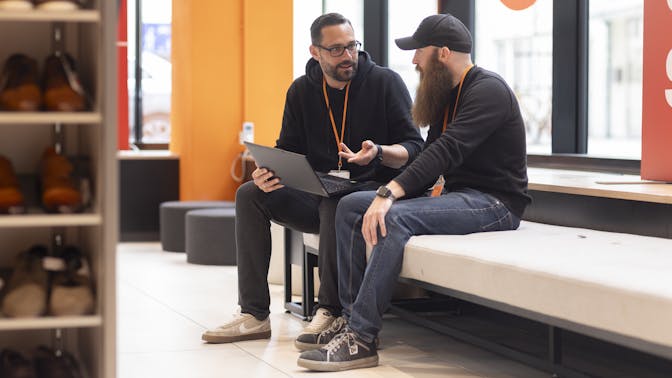
Building resilience: Insights from leadership and experience in content solutions
Roland Butler is the Head of Product for Content Solutions at Zalando, driving the systems that power content creation across teams. In this article, Roland shares insights on building resilience in tech leadership, drawing from his experience leading Content Tech teams and his recent talk at the LeadDev conference.
6 min
02 April 2025

My name is Roland Butler and I lead the Content Tech teams at Zalando. Our team is responsible for all the systems that are used to add content, from text and translations to pictures and videos. Every day, we ensure that thousands of products from our own studios and our partner studios receive high-quality content. We also help creative strategy teams in getting their content made and published through CMS systems that are managed by other teams.
We actually work within a fashion studio, not an office setting, and while we are a dedicated tech team for Content Solutions, we build for all of Zalando. Our tools are used by teams across the company who need content operations support—from Lounge Studios teams to AI-based tagging systems and complex logistics like ordering product samples across Europe.
The power of resilience in tech
As a product and technology leader, resilience is an important muscle to develop and exercise. As part of your job, you're required to explore difficult topics, take risks, and be accountable for deciding when good intentions are working against us rather than for us. In a role like that not everything you try is going to work, or be any good. So, resilience in the form of the ability to get back up after setbacks, reflect, re-motivate yourself, and keep moving forward is super important and defines long-term success.
My presentation at LeadDev covered the topics of resilience in tech leadership. Not all initiatives will succeed, which makes the ability to recover and persist essential. I drew upon my experience before Zalando, where I led product and tech teams at Just Eat and some smaller startups, including restaurant booking, used car sales, and financial markets publishing. Instead of treating resilience as an abstract concept, it can be cultivated through daily habits, continuous learning, and mindset shifts.
Small steps towards resilience
One of the most effective ways to build resilience is to stay connected with the people whose lives you’ll impact with your software. It’s a great way and a simple trick to motivate yourself and a really easy small step you can take: Get on the ground and meet customers or users. See how they work and then bring those reflections back to the team to see how to make it better.
Beyond this small step towards resilience that all tech professionals can take, there are a number of guiding principles that I use:
Trust your instincts: If you have an idea that feels like the right thing to do, you have supporting data, and would do it if you were in charge, then you should probably go for it. Even if the data is imperfect, find a way to move and you will get more data. Important: Don’t be afraid to walk away from bad decisions you make. But most of all, don’t let the fear of bad decisions create stagnation. The company that wins is often the company that is faster to make decisions, even if some of them are wrong. Avoid debating the perfect plan while your competitor is learning by doing, even if what they are doing does not always work.
Reframe big challenges: If the project is huge or obstacles seem insurmountable, as a lead you have to avoid the reverse onion scenario. This is where you evaluate all the right things to do and the do them all, but end up crying because there are so many layers of process that in the end nothing moves. One trick to avoid this is to set yourself an artificial time limit. Ask yourself, "If we had to do all of this by next week, what would we do?", or, “If I were leaving in 30 days, how would I wrap this up if I absolutely had to get everything straight?” These mindset shifts can reveal new paths.
Prioritise people: Whether there are colleagues or customers involved, do right by them and the rest will follow.
And what if none of that works? If you're still stuck then close your laptop and go for a walk or pick up the phone and talk to someone you haven't spoken to in a while. Then start again the next day.
Learning from failures: retrospectives that work
Across our teams at Zalando, I believe we practise hyper-transparency. I appreciate that engineering teams need focus, so you need to reduce the noise. But if a question comes up, answer it directly with all the information you have.
If it is about failure, an effective strategy for a tech team retrospective should start with the question "what did we learn?". The second is, “how can we apply that learning to make us better the next time?”. Extracting insights helps teams improve and evolve.
Managing workload: the art of over-communication
One of the biggest challenges in tech leadership is managing finite capacity. My advice? Over-communicate. It's a cliche but over-communication is key. If you are leading a team, make sure everyone knows what needs doing and why. Tell the story so that it sticks: in meetings, written updates, in presentations, or even when someone asks you to give a talk at a developer meet-up—so that the message sticks.
At the same time, always hold some capacity in reserve. Unexpected challenges will arise, and if you’re already stretched to the limit, everything grinds to a halt. Leave room for flexibility to ensure that your team can handle surprises without breaking momentum.
Like any good advice, I first heard this from my former bosses. At the time, it sounded ridiculous—but over the years, I’ve had to admit (begrudgingly) that they were right.
The role of Zalando’s OFMs in resilience
The most relevant OFMs (Our Founding Mindsets) are the customer-centric ones, because they provide a strong foundation for resilience:
Always put yourself in our customer’s shoes:
Everything starts with the customer. We always ask: are we delivering our customer promises? Are we creating memorable moments?
Solve something that matters:
We start with an experience worth creating and then work backwards. To achieve desired outcomes, we focus on critical inputs that we can control.
Put purpose first, ego second:
We stay humble and trust that our personal success comes from making the best decisions for the customer.
Building resilience isn’t about having all the answers. It’s about staying open to learning, embracing setbacks as growth opportunities, and taking small steps forward every day towards achievements.

